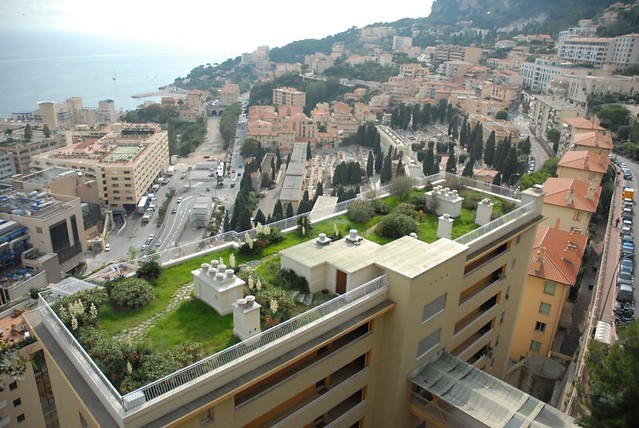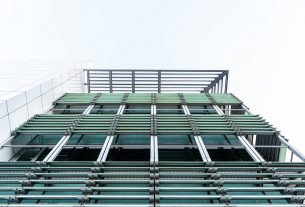Flat roofs are gradually taking over our homes, to the detriment of sloping and rounded roofs. It allows us to benefit from outdoor living space and to make the most of the square meters, especially in the city. Nowadays, many flat roofs are being transformed into green roofs, which also offer the advantage of insulating from heat and cold.
There are two types of green roofs:
– Intensively vegetated roofs:
◦ these are suspended gardens: we speak then of roof terrace;
◦ they require a substrate with a thickness greater than or equal to 15 cm, as well as a watering system;
◦ they are systematically installed by professionals.
– Extensively vegetated roofs:
◦ they require a substrate with a thickness of at least 5 cm, which can be up to 15 cm;
◦ they are ideal for poor soil;
◦ the watering system is optional;
◦ they can be made by amateurs.
Green roof: many advantages

The green roof offers many advantages, especially with regard to insulation:
– from the cold;
– from bad weather;
– noise;
– draughts.
A grassy substrate is also very fire-resistant and prolongs the life of the building.
From an ecological point of view:
– The plants on the roof fix dust and pollen by raising the humidity level in the polluted air of urban areas.
– The earth absorbs lead and carbon particles, which lowers the level of CO2 in the air.
Please note: rotting of the structure is not to be feared if care is taken to protect it with a suitable tarpaulin and to create complete drainage.
Installation of the extensive green roof
In the case of small areas, it is possible to install the system yourself by following certain rules:
– Respect of the slope:
◦ slope of 5° minimum up to 35° with anti-slip restraint system;
◦ creation of a structure of wood, concrete, etc.
– Creation of a watertightness:
◦ use of an EPDM tarpaulin, sold in rolls of different widths, to avoid too many joints;
◦ a basin cover can also be used.
– Creation of drainage:
◦ in expanded clay;
◦ in crushed brick;
◦ in pozzolana;
◦ with a drainage membrane, etc.
– Laying of an anti-root veil in:
◦ non-woven fabric;
◦ geotextile;
◦ felt, etc.
– Laying of a 7 to 15 cm thick, light, water-retaining substrate.
– Planting and making the peripheral strip of gravel.
– Organic fertilizer may be necessary for the first year.
Caution: your substrate must be strong enough to support the greening of the roof: indeed, the greened roof can weigh between 300 and 400 kg/m².
Maintenance of the green roof: watering and weeds

It is necessary to check in the first year that wild grasses do not establish themselves. If this is the case, manual weeding will be unavoidable.
In addition, we must weed 4 times a year to ensure the plants’ survival: otherwise, they will suffocate under the proliferation of wild plants, which are often invasive.
In summer, watering is often mandatory, especially in case of high heat. The substrate being thin, it dries out very quickly.
Plants adapted to green roofs
Ground cover plants should be chosen to ensure good coverage that prevents weeds from settling. They will also help stabilize the substrate. Sedum is a plant that is particularly suitable for flat roofs. This category includes more than 400 species of rock plants or small perennial shrubs, which:
– stabilize the soil;
– support poor, draining soil;
– require relative watering.
You can, of course, choose to mix sedums for aesthetic reasons.
Here are a few recommendations for the choice of plants for your roof terrace:
– harmonize the color of the foliage;
– choose persistent or semi-persistent sedums with late flowering;
– find out about the plants that can withstand your climate:
◦ humid winters, Mediterranean climate, etc.;
◦ exposure (south-facing), shady, etc.).
Price of a green roof: about $40 per m².
You will find in the table below a summary of the estimated prices for a 100 m² green roof:
| Type of product for a 100 m² green roof | Price range |
| Waterproofing (EPDM fabric) | Approximately $1350 |
| Drainage and geotextile film | About $900 |
| Substrate (topsoil + pozzolana to a thickness of 10 cm) | About $600 |
| Vegetation | Between $300 and $400. |
Can you install or renovate a roof yourself?

Doing your own roofing can save you money, but requires a lot of know-how. Be careful, the work you do yourself is not guaranteed in case of faulty workmanship, and any subsequent damage that may result is not covered by insurance.
It is best to follow the advice of a professional roofer, especially when installing a new roof.
As you will have understood, the design or total renovation of a roof is reserved for professionals.



